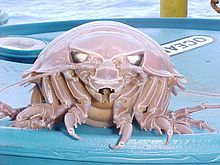Important Facts For Prelims
Bathynomus raksasa: Isopod Species
- 20 Jul 2020
- 2 min read
Why in News
Recently, scientists have reported the discovery of the first super giant isopod species in the eastern Indian Ocean named ‘Bathynomus raksasa’.
- It has been described as the ‘cockroach of the sea’.
- A team of researchers from Singapore discovered it while exploring waters of the Indian Ocean in Bantan, off the southern coast of West Java in Indonesia in 2018.
Key Points
- Super Giant Isopod: The Bathynomus raksasa is a super giant isopod in the genus Bathynomus.
- Isopods are marine invertebrates (animals without backbones) that belong to the greater crustacean group of animals, which also includes crabs and shrimp.
- They live in many different types of habitat, from mountains and deserts to the deep sea.
- Isopods that reach 50 cm are referred to as supergiants. The largest isopod species are from the genus Bathynomus.
- Features:
- It has 14 legs but uses these only to crawl along the bed of oceans in search of food.
- It measures around 50 cm in length, which is big for isopods, which normally do not grow beyond 33 cm.
- The only member of the isopod species that exceeds the raksasa in size is the Bathynomus giganteus, which is commonly found in the deep waters of the western Atlantic Ocean.
- As a scavenger, it eats the remains of dead marine animals, such as whales and fish, but can also go for long periods without food, a trait that it shares with the cockroach.
- Significance:
- It is the first recorded species of the genus Bathynomus from Indonesia.
- It is the sixth ‘supergiant’ species from the Indo-West Pacific, and is one of the largest known members of the genus Bathynomus.
- It’s discovery will contribute towards increasing knowledge about the deep sea.




